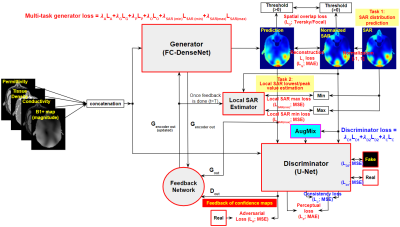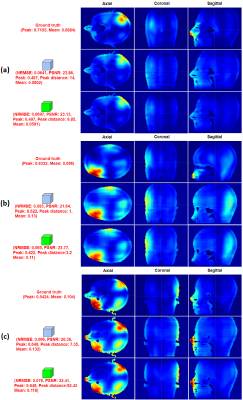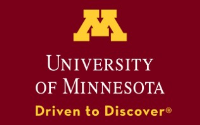Jinyoung Kim1, Alireza Sadeghi-Tarakameh1, Angel Torrado-Carvajal2,3, and Yigitcan Eryaman1
1Center for Magnetic Resonance Research, Department of Radiology, University of Minnesota, Minneapolis, MN, United States, 2Athinoula A. Martinos Center for Biomedical Imaging, Department of Radiology, Massachusetts General Hospital and Harvard Medical School, Boston, MA, United States, 3Medical Image Analysis and Biometry Laboratory, Universidad Rey Juan Carlos, Madrid, Spain
1Center for Magnetic Resonance Research, Department of Radiology, University of Minnesota, Minneapolis, MN, United States, 2Athinoula A. Martinos Center for Biomedical Imaging, Department of Radiology, Massachusetts General Hospital and Harvard Medical School, Boston, MA, United States, 3Medical Image Analysis and Biometry Laboratory, Universidad Rey Juan Carlos, Madrid, Spain
The proposed multi-task
feedback adversarial network can be used to predict 10g-averaged local SAR, which
is critical for patient safety at ultrahigh-field imaging.

Fig.
1. The proposed multi-task learning model. The generator loss newly incorporates
perceptual loss, local SAR min/max loss, and spatial overlap loss using combined Tversky and
focal loss function10 to penalize overlap
errors in the higher SAR. The discriminator loss includes
consistency loss between outputs from the real SAR and its AugMix11 version to improve the
robustness to data shift. The model parameters are initialized with He normal12 and optimized with ADAM.13 Learning rate is 0.0001 and
reduces after 40 epochs. The size of mini-batches is 8,
and the number of epochs is 100.

Fig.
5. Visualization examples of local SAR prediction on a specific case of (a) Duke,
(b) Ella, and (c) Louis head models. For simplicity, the center slices in each
axis are visualized. Overall, local SAR distribution is comparable to ground
truth SAR. We observed discontinuity between slices in the SAR prediction with peak
values estimated slice by slice (blue). Bone and air information was predicted
due to tissue properties data.
